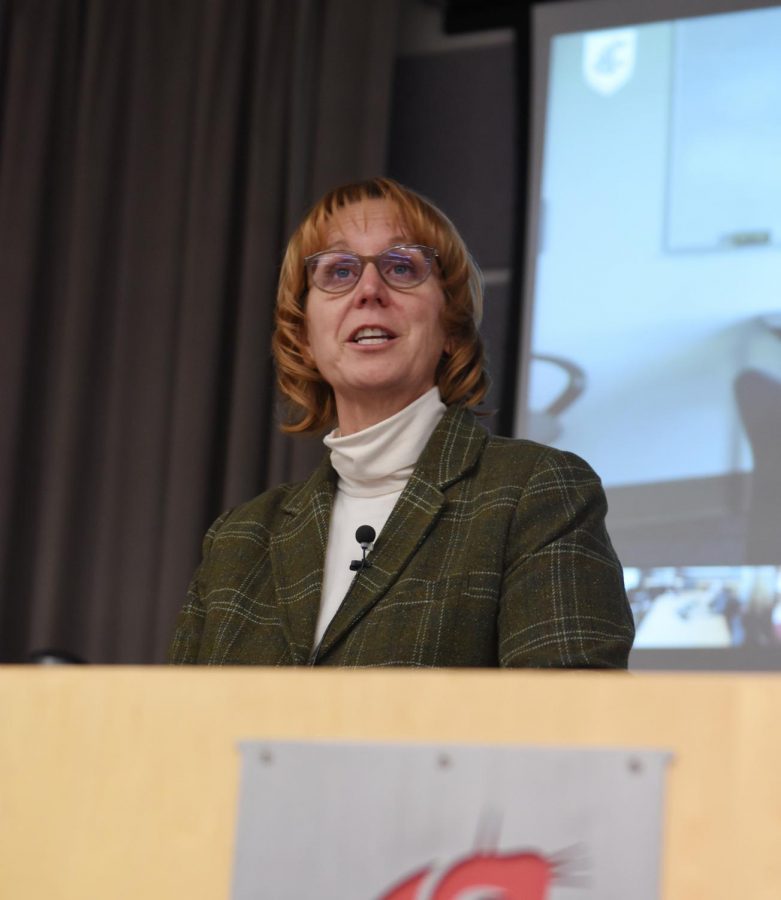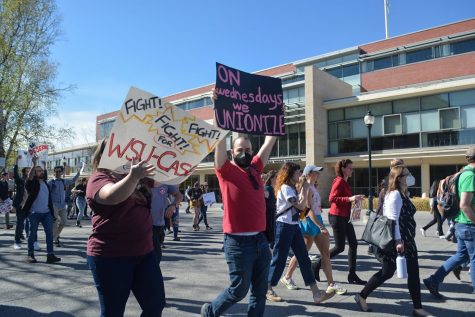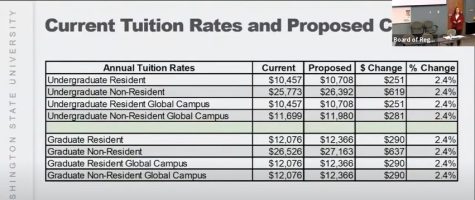Budget issues rooted in 2014 loan forgiveness
Late president forgave almost $50 million in construction-related, athletic expenses
BONNIE JAMES | THE DAILY EVERGREEN
Judi McDonald presents the late president Elson S. Floyd’s loan forgiveness numbers at the Jan. 25 Faculty Senate meeting.
February 9, 2018
Faculty Senate Chair Judi McDonald read aloud financial figures at a Jan. 25 Faculty Senate meeting outlining a series of forgiven loans within the university, which are some of the root causes of WSU’s current financial woes.
The university’s reserves were used to forgive loans totaling $48.9 million during late President Elson S. Floyd’s presidency, according to figures compiled by the President’s Office
Phil Weiler, vice president of marketing and communication, said expenses forgiven in fiscal year 2014 — including $13 million to cover the athletics department’s deficit, $10 million for the Palouse Ridge Golf Course and Clubhouse and $5.3 million for Spokane real estate — were largely responsible for current budget shortfalls.
A variety of sources, including tuition dollars, gifts and state appropriation, make up central reserves.
In October 2017, WSU President Kirk Schulz announced a plan to relieve a $30 million deficit in three fiscal years by cutting each unit’s spending by 2.5 percent, keeping vacant employee positions open and eliminating the Performing Arts program.
Recent investments in new buildings also put a big dent in funds, Weiler said. He said the Washington State Legislature funds the construction of the buildings, but not the maintenance and operations, so the university is now struggling to pay for employees who upkeep the building.
Since reserves have been drawn down to such a degree, Weiler said. It is now difficult to deal with budget issues.
“We need to be in that saving mode as opposed to that investing mode,” Weiler said.
85 percent of the expenses that the university spends every year has to do with personnel costs, he said. Most employees are paid by that state, Weiler said, and even if an employee leaves or retires, the state still funds their position’s salary and benefits. This means if employees stop working, one of the best ways to build up reserves is to leave the positions open for a while and allow state money to collect in reserves, he said.
Weiler, who was not at the university during Floyd’s presidency, said loan forgiveness is within the powers of the president, but because Floyd died shortly after he made the decision to forgive the loans, it is hard to know if he had a long-term follow-up. He said many people did not seem to know that he was terminally ill and there was not a chance for a proper transition between presidents.
The Board of Regents were involved in approving major expenditures like the Elson S. Floyd Cultural Center and SPARK building, he said, but he does not know if they played a role in Floyd’s decision to forgive the loans.
Weiler said Schulz feels it is important for the Regents to have good insight into the budget and wants people to see what the budget looks like through resources like the fiscal health website.
He said now the administration needs to figure out how to fund on an ongoing basis.
Loan forgiveness total breakdown:
President Floyd forgave $26.7 million in internal university loans for a variety of different projects including
Golf Course & Clubhouse – $10.10 million
Deficit coverage for WSU Athletics when former athletic director Jim Sterk was hired – $3.8 million
Additional accumulated deficits for WSU Athletics – $4.5 million
Spokane Real Estate purchase – $5.3 million
Relocation costs for Veterinary Medicine – $1.8 million
Loan for Parking Renovations – $1.2 million
Additionally, WSU did not have the following expenses budgeted, which resulted in $22.2 million additional deficit
Fiscal Year 2014 WSU Athletics annual deficit – $13.3 million
Overspending Financial Aid funds – $2.7 million
ESF Medical School consultants – $1.7 million
WSU Everett IT purchases – $1.2 million
All other areas – $3.3 million
















